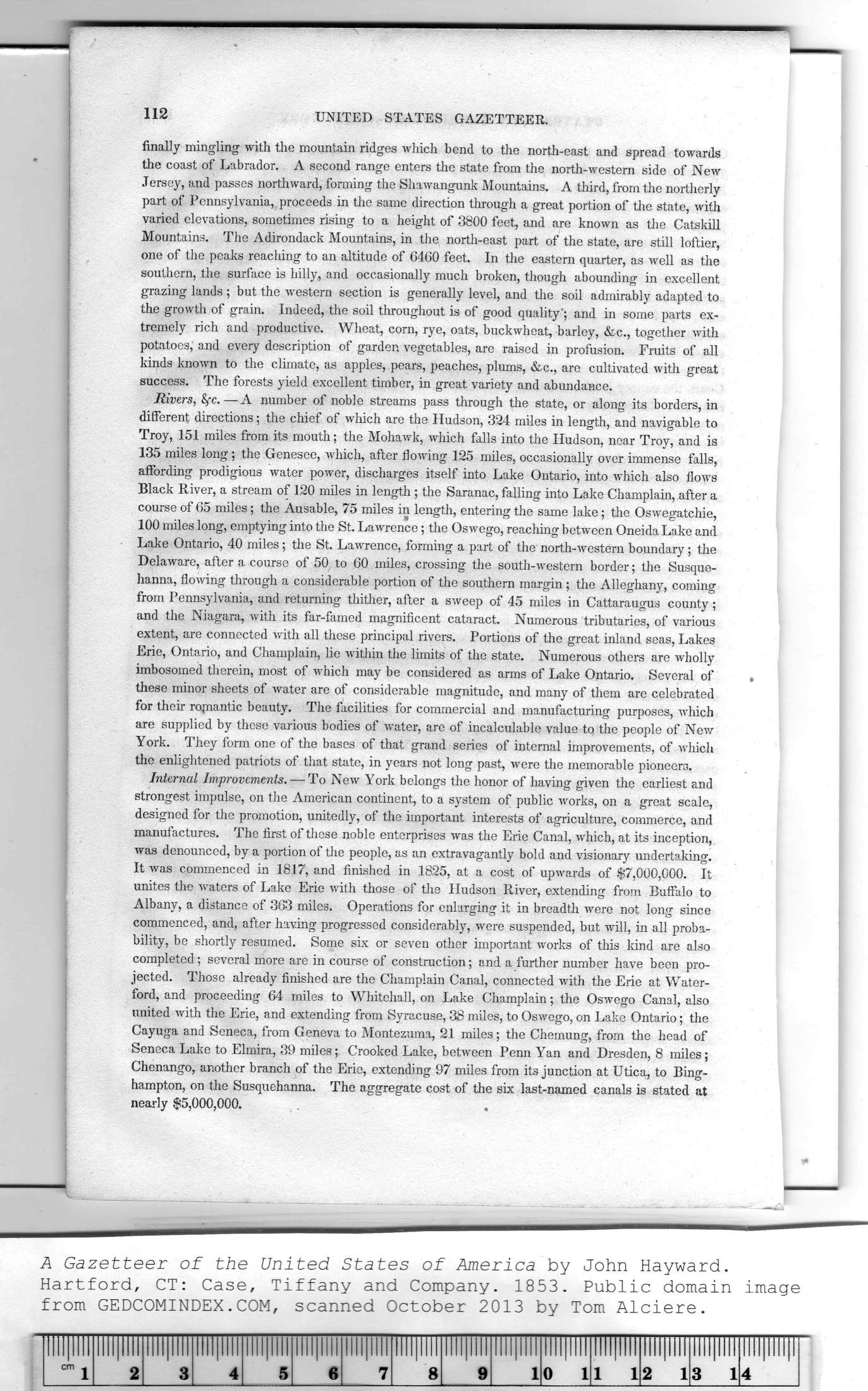|
|
Note: Ctrl and + increases the font size of the text below, Ctrl and - decreases it, and Ctrl and 0 resets it to default size.
112 UNITED STATES GAZETTEER.
finally mingling with the mountain ridges which bend to the north-east and spread towards
the coast of Labrador. A second range enters the state from the north-western side of New
Jersey, and passes northward, forming the Shawangunk Mountains. A third, from the northerly
part of Pennsylvania, proceeds in the same direction through a great portion of the state, with
varied elevations, sometimes rising to a height of 3800 feet, and are known as the Catskill
Mountains. The Adirondack Mountains, in the north-east part of the state, are still loftier,
one of the peaks reaching to an altitude of 6460 feet. In the eastern quarter, as well as the
southern, the surface is hilly, and occasionally much broken, though abounding in excellent
grazing lands ; but the western section is generally level, and the soil admirably adapted to
the growth of grain. Indeed, the soil throughout is of good quality'; and in some parts ex-
tremely rich and productive. Wheat, corn, rye, oats, buckwheat, barley, &c., together with
potatoes, and every description of garden vegetables, are raised in profusion. Fruits of all
kinds known to the climate, as apples, pears, peaches, plums, &c., are cultivated with great
success. The forests yield excellent timber, in great variety and abundance.
Rivers, fyc. — A number of noble streams pass through the state, or along its borders, in
different directions; the chief of which are the Hudson, 324 miles in length, and navigable to
Troy, 151 miles from its mouth; the Mohawk, which falls into the Hudson, near Troy, and is
135 miles long; the Genesee, which, after flowing 125 miles, occasionally over immense falls,
affording prodigious water power, discharges itself into Lake Ontario, into which also flows
Black River, a stream of 120 miles in length ; the Saranac, falling into Lake Champlain, after a
course of 65 miles; the Ausable, 75 miles in length, entering the same lake; the Oswegatchie,
100 miles long, emptying into the St. Lawrence ; the Oswego, reaching between Oneida Lake and
Lake Ontario, 40 miles; the St. Lawrence, forming a part of the north-western boundary; the
Delaware, after a course of 50 to 60 miles, crossing the south-western border; the Susque-
hanna, flowing through a considerable portion of the southern margin ; the Alleghany, coming
from Pennsylvania, and returning thither, after a sweep of 45 miles in Cattaraugus county;
and the Niagara, with its far-famed magnificent cataract. Numerous tributaries, of various
extent, are connected with all these principal rivers. Portions of the great inland seas, Lakes
Erie, Ontario, and Champlain, lie within the limits of the state. Numerous others are wholly
unbosomed therein, most of which may be considered as arms of Lake Ontario. Several of
these minor sheets of water are of considerable magnitude, and many of them are celebrated
for their ropiantic beauty. The facilities for commercial and manufacturing purposes, which
are supplied by these various bodies of water, are of incalculable value to the people of New
York. They form one of the bases of that grand series of internal improvements, of which
the enlightened patriots of that state, in years not long past, were the memorable pioneers.
Internal Improvements. — To New York belongs the honor of having given the earliest and
strongest impulse, on the American continent, to a system of public works, on a great scale,
designed for the promotion, unitedly, of the important interests of agriculture, commerce, and
manufactures. The first of these noble enterprises was the Erie Canal, which, at its inception,
was denounced, by a portion of the people, as an extravagantly bold and visionary undertaking.
It was commenced in 1817, and finished in 1825, at a cost of upwards of $7,000,000. It
unites the waters of Lake Erie with those of the Hudson River, extending from Buffalo to
Albany, a distance of 363 miles. Operations for enlarging it in breadth were not long since
commenced, and, after having progressed considerably, were suspended, but will, in all proba-
bility, be shortly resumed. Some six or seven other important works of this kind are also
completed; several more are in course of construction; and a further number have been pro-
jected. Those already finished are the Champlain Canal, connected with the Erie at Water-
ford, and proceeding 64 miles to Whitehall, on Lake Champlain; the Oswego Canal, also
united with the Erie, and extending from Syracuse, 38 miles, to Oswego, on Lake Ontario; the
Cayuga and Seneca, from Geneva to Montezuma, 21 miles; the Chemung, from the head of
Seneca Lake to Elmira, 39 miles; Crooked Lake, between Penn Yan and Dresden, 8 miles;
Chenango, another branch of the Erie, extending 97 miles from its junction at Utica, to Bing-
hampton, on the Susquehanna. The aggregate cost of the six last-named canals is stated at
nearly $5,000,000.
|
Illllllll |
llll llll |
Illllllll |
Illllllll |
llll|llll |
Illllllll |
llll|llll |
Illllllll |
llll|llll |
Illllllll |
Illllllll |
Illllllll |
Illllllll |
Illllllll |
iiii imp |
|
cm j |
2 |
3 |
4 |
5 |
6 |
7 |
8 |
9 |
1 |
0 1 |
1 1 |
2 1 |
3 1 |
4 |
|
